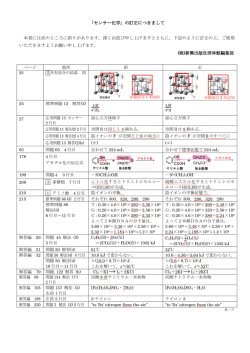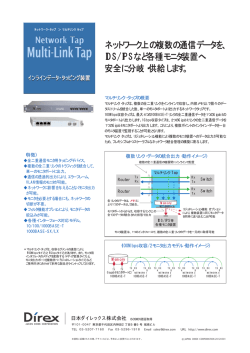
P2-140
JUICE-‐JAPAN WG 木星氷衛星探査計画 JUICE-‐SWI サブミリ波分光計 笠井康子1,2、佐川英夫2、黒田剛史3、関根康人4、菊池健一2、西堀俊幸5、真鍋武嗣6、落合啓2、Submillimetre Wave Instrument (SWI) チーム (東工大・NICT・東北大・東大・JAXA・大阪府立大) サブミリ波分光計(Submillimetre Wave Instrument:SWI)は600GHz 帯と 1200GHz 帯における放射を受信するヘテロダイン分光計である. ガニメデ/エウロパなど氷衛星における大気組成を同定することにより、氷衛星のハビタビリティに迫る. また、地表面氷、木星大気の風 速・気温・分子の観測を行う.アンテナは口径30cm の主鏡を持ち,約 0.057 度(1.2THz)のビーム幅を実現する.SWI 国際チームにおける 日本チームの分担はアンテナ開発である.反射鏡やその支持構造は木星圏の強力な放射線による劣化を避けるため,複合材を用いず アルミニウム合金で製作することを検討している. SWI 概要 SWI Science Goals S1. ExploraHon of the habitable zone: Ganymede, Europa, and Callisto S2. Explore the Jupiter system as an archetype for gas giants Science objecHves S1-‐1 : Characterise Ganymede as a planetary object and possible habitat S1-‐2 Explore Europa’s recently acHve zones SWI objecHves Structure, dynamics and composiHon of atmospheres/exospheres of Galilean satellites Important isotopes in the atmospheres of Jupiter and the Galilean satellites Thermophysical properHes of Ganymede and Callisto surfaces S1-‐3 : Study Callisto as a remnant of the early jovian system S2-‐1 : Characterise the Jovian atmosphere Structure, dynamics and composiHon of the Jovian stratosphere from 400 to 0.01 hPa. Direct wind measurements! S2-‐2 : Explore the Jovian magnetosphere No contribuHon S2-‐3 : Study the Jovian satellite and ring systems Remote sensing observaHon of Io’s atmosphere and surface Signatures of water (blue) detected by Hubble are overlayed on an image of Europa ScienHfic requirements of SWI Importance as an “ocean planet”: planetary processes and chemical evoluHon Icy moon → Comparison of Ganymede and Callisto (and Titan, Enceladus…) chemical reacHons in the deep ocean Similarity in size and difference in thermal evolu*on between them allow us to understand planetary processes Deep-‐water magma ocean on Ganymede during accreHon? AcHve water-‐rock interacHons? → O isotopes Massive escape of proto-‐atmosphere → D/H ra*o Chemical evoluHon (organic synthesis) on Ganymede? Forma*on model of large icy satellite (Kuramoto & Matsui, 1994) Atmosphere 3-‐D profiles of temperature, winds, and atmospheric composi9ons Surface Ganymede regolith studies: Determine surface brightness temperatures in 600 and 1200 GHz bands with high spaHal resoluHon Constrain amplitude and phase of thermal wave within the first cenHmeter of the regolith Determine thermo-‐physical properHes of the regolith Correlate surface features with atmosphere features Jupiter Highly resolved 3-‐D monitoring of tracers: ci Ganymede/ Callisto: 17-‐O, 18-‐O, D, O/P, O2 Search for new species 13-‐C, NH3, CH3OH, H2CO,HC3N, CH3CCH CH3OH, H2CO, halides(HCl…)… 17-‐O, 18-‐O, D, CN, C3N, CS, C3S, 13-‐C, 15-‐N, 34-‐S(HCN, CO, CS) VerHcal res. 1 km ~ scale height SpaHal res. 2 – 10 km < 5 degrees, T [K] < 2 K (accuracy) <5K in collisional range Doppler winds: 10 m/s カセグレンである SL-‐9 impact: CS, HCN, CO external oxygen/water supply of uncertain origin Direct (Doppler) wind measurements (3-‐D): 10 m/s accuracy (CH4, H2O) Basic specificaHon of SWI Isotopic composi*ons of ice at Jupiter Snowlines & isotopic exchanges in the solar nebula → Indicator of the disk condiHons Exchange of isotopes HomogenizaHon Proto -‐sun H2O (160 K) CO2 (80 K) d u o l c r la Molecu cHons ea & UV r NH3, CH4 (50 K) N2, CO (30 K) Protoplanetary disk H2 H2O H2 H2 H O 2 N2 N2 H2 H2 H2 N2 H2O NH3 H2 rock CO rock CO H2 H2O H2 H2O NH3 N2 H2O NH3 rock CO H2 高速ジェット の存在? 風速の直接観測 気温と微量成分の3次元構造 対流圏 ⇔ 成層圏 ⇔ 熱圏 にお けるエネルギー・物質の循環・相 互作用を明らかに SWIアンテナ系開発 SWIのアンテナはJEM/SMILESで実績があるアルミ合金(A7075-‐T7351)による熱相似変形則を持つ設計を適用するため,軸受け, 締結部品を除く,主鏡,副鏡,第三鏡,支持構造,ギアを全てアルミ合金で製作し,熱による反射面の不規則な変形モードを発生 させない設計とする.また同時に,放射線に対して劣化が無い金属面を反射面とすることが出来る.アンテナ光学系概要とスケ ジュールを以下に示した. SWIの光学系はアンテナ系(主鏡,副鏡,第三鏡)と第四鏡,ワイヤーグ リッド,ホーンからなるシンプルな構成である.受信機の較正は,常温較正 源と深宇宙のマイクロ波背景放射を受信することで行う.常温較正源とア ンテナのビームの切り替えを行うため,受信機ユニット内に切り替え用のミ ラーを持つ.600GHz帯と1.2THz帯のビームの切り替えはワイヤーグリッド を用いた偏波選択により実現する.受信機の雑音温度を下げるため,ミク サは放射冷却により120K程度で運用する予定である. 光学系の駆動要求 -> Mechanical design driven by optics! -> Optics design driven by science! 体制 4° JUICEの打ち上げは2022年,開発モデルはSWIサブシステムとしてDM, STM,EQM,FMの提供が要求されている. 60° SituaHon Distance to Jupiter: Primary: Scanning: Science requirement: PoinHng knowledge: 10^6 km (15 RJ) 30cm 2-‐axis: +/-‐ 4° (limb) 1-‐axis: +/-‐ 60° (moons) 10 m/s (winds in limb) 11.5 arcsec 図 12.3.5-1 全体スケジュール
© Copyright 2025

